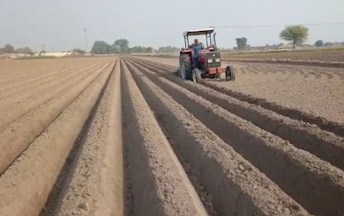Potential of Potato Farming in Pakistan
Introduction
Potato, the humble tuber, has emerged as one of the vital crops in Pakistan's agricultural landscape. Known for its versatility, nutritional value, and adaptability to various agro-climatic regions, potato farming has become a significant contributor to both the country's economy and food security. This article delves into the world of potato farming in Pakistan, exploring its growth, challenges, and the promising future that lies ahead.
https://agriera.blogspot.com/2023/09/production-technology-of-rice-part-1.html
https://agriera.blogspot.com/2023/10/canola.html
https://agriera.blogspot.com/2023/09/cotton-gossypium-spp-production.html
Historical Perspective
Geographical Distribution
Climatic Condition
Potato Varieties
Plantation and Crop Management
- Planting
Potatoes are typically grown from seed potatoes, which are tubers saved from the previous harvest. Planting is done in furrows or ridges at an appropriate depth to ensure adequate spacing between plants.
- Fertilization
Soil testing guides fertilization practices, with balanced nutrient applications of nitrogen, phosphorus, and potassium. Organic matter and micronutrients may also be added to enhance soil fertility.
- Irrigation
Potato plants require consistent moisture throughout their growth cycle. Modern irrigation techniques, including drip and sprinkler systems, are employed to optimize water use and prevent diseases associated with waterlogging.
- Weed Control
Weed management is crucial to prevent competition for nutrients and sunlight. Herbicides, manual weeding, or mechanical cultivation are employed.
- Disease and Pest Management
Common potato pests and diseases in Pakistan include late blight, aphids, and potato cyst nematodes. Integrated pest and disease management (IPM) strategies combine chemical control, biological control, and cultural practices.
- Hilling
Hilling involves mounding soil around the base of potato plants, which helps prevent exposure to sunlight and reduces the risk of tuber greening.
- Harvesting
Potatoes are harvested when they reach the desired maturity, which varies depending on the intended use. Hand harvesting or mechanical harvesters are employed to avoid damage to the tubers.
- Post Harvest Handling
Proper handling and storage are crucial to maintain potato quality. Potatoes are cured, cleaned, and stored in well-ventilated, temperature-controlled storage facilities.
Market Demand and Economic Impact
The demand for potatoes in Pakistan is substantial, driven by the country's growing population and changing dietary habits. Potatoes are consumed as a staple food, and their versatile nature makes them suitable for a wide range of products, including chips, snacks, and processed foods.
Potato farming contributes significantly to Pakistan's economy, providing income and employment opportunities to millions of farmers and farm laborers. The potato value chain encompasses production, transportation, processing, and marketing, further generating economic activity.
Challenges in Potato Farming
While potato farming in Pakistan has shown remarkable growth, it faces several challenges:
Disease and Pest Pressure
Potato crops are susceptible to various diseases and pests, with late blight being a significant concern. Continued research and development of resistant varieties and IPM strategies are essential to combat these challenges.
Storage and Post-Harvest Losses
Inadequate storage facilities and post-harvest losses due to poor handling and infrastructure remain a significant issue. Investments in modern storage and cold chain infrastructure are needed.
Access to Quality Seed
The availability of certified seed potatoes is limited in some regions, hindering the adoption of improved varieties and leading to yield variability.
Market Access and Pricing
Small-scale farmers often struggle with market access, fair pricing, and value addition opportunities. Strengthening market linkages and creating avenues for processing could mitigate this issue.
Climate Change
Changing weather patterns, including temperature fluctuations and irregular rainfall, pose a threat to potato production. Adaptation measures and resilient varieties are necessary to address these challenges.
Research and Innovation
The agriculture research sector in Pakistan plays a pivotal role in developing and disseminating improved potato varieties and technologies. Research institutions like the National Potato Research Program (NPRP) work on breeding, disease resistance, and agronomic practices to enhance potato farming.
Furthermore, innovation in potato farming technology, including precision agriculture, the use of drones for crop monitoring, and soil health management, is gradually gaining traction, enabling farmers to make data-driven decisions and optimize resource use.
Future Prospects
Despite the challenges, the future of potato farming in Pakistan appears promising. There is an increasing recognition of the crop's potential to contribute to food security, livelihoods, and rural development.







Comments
Post a Comment